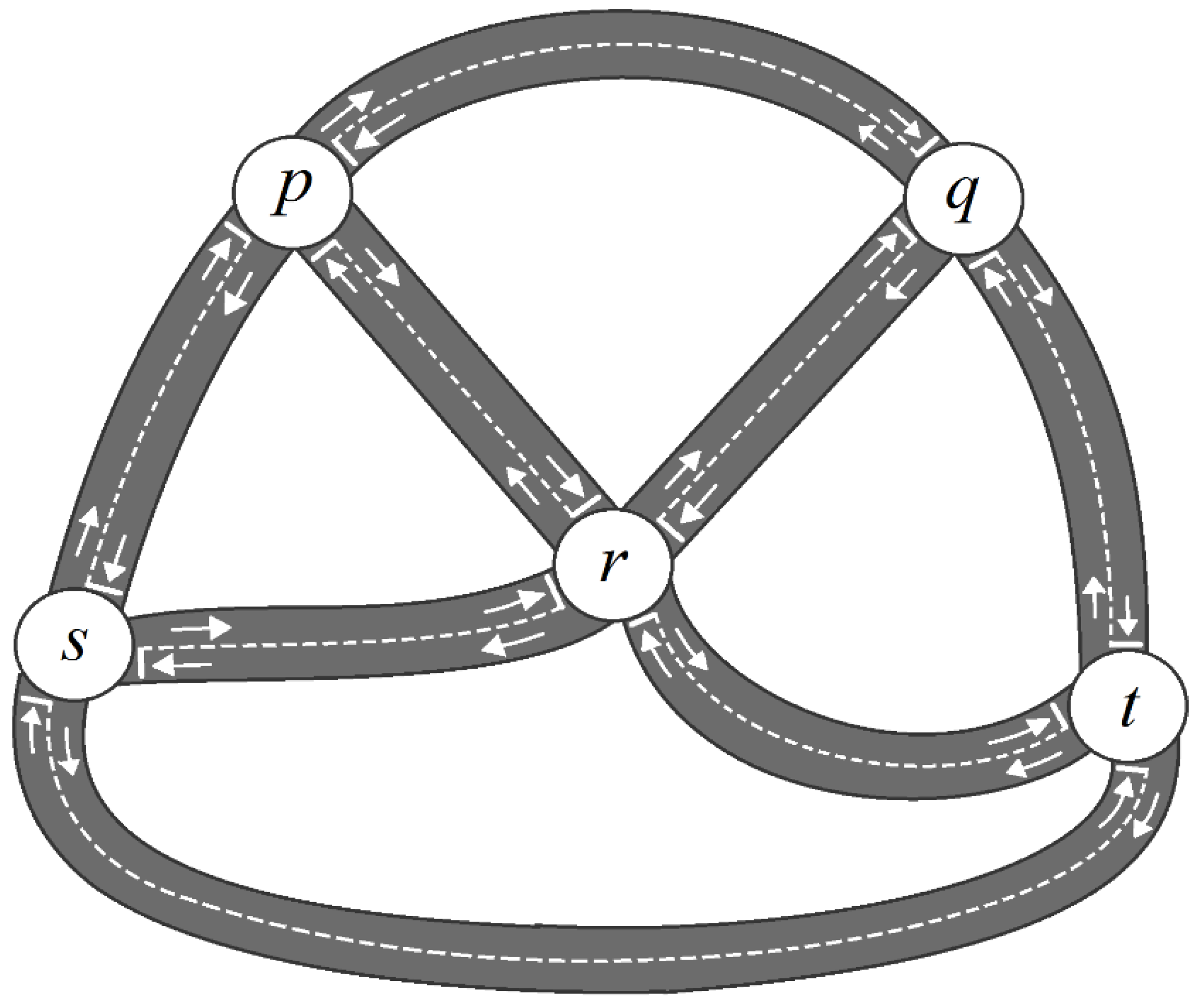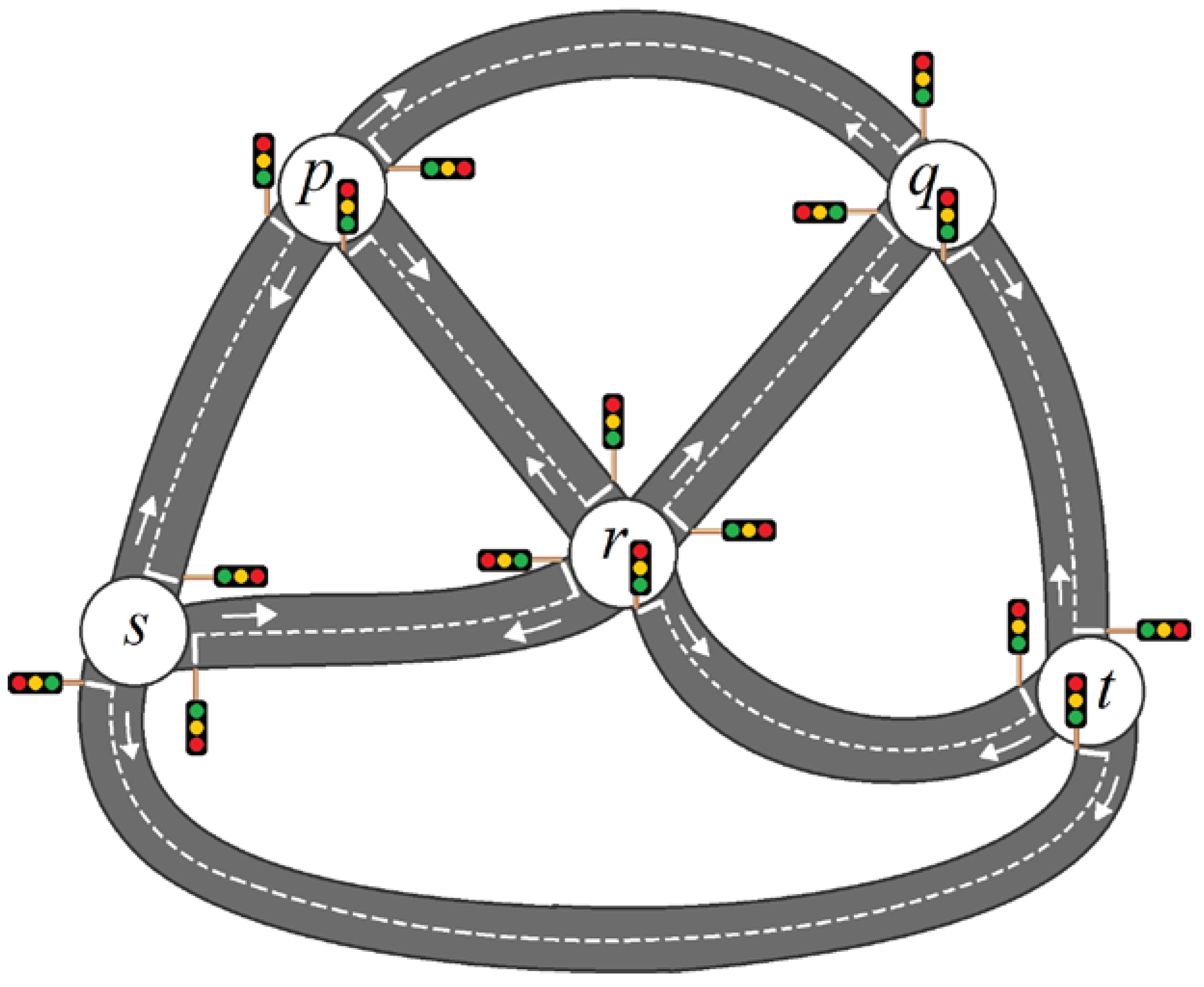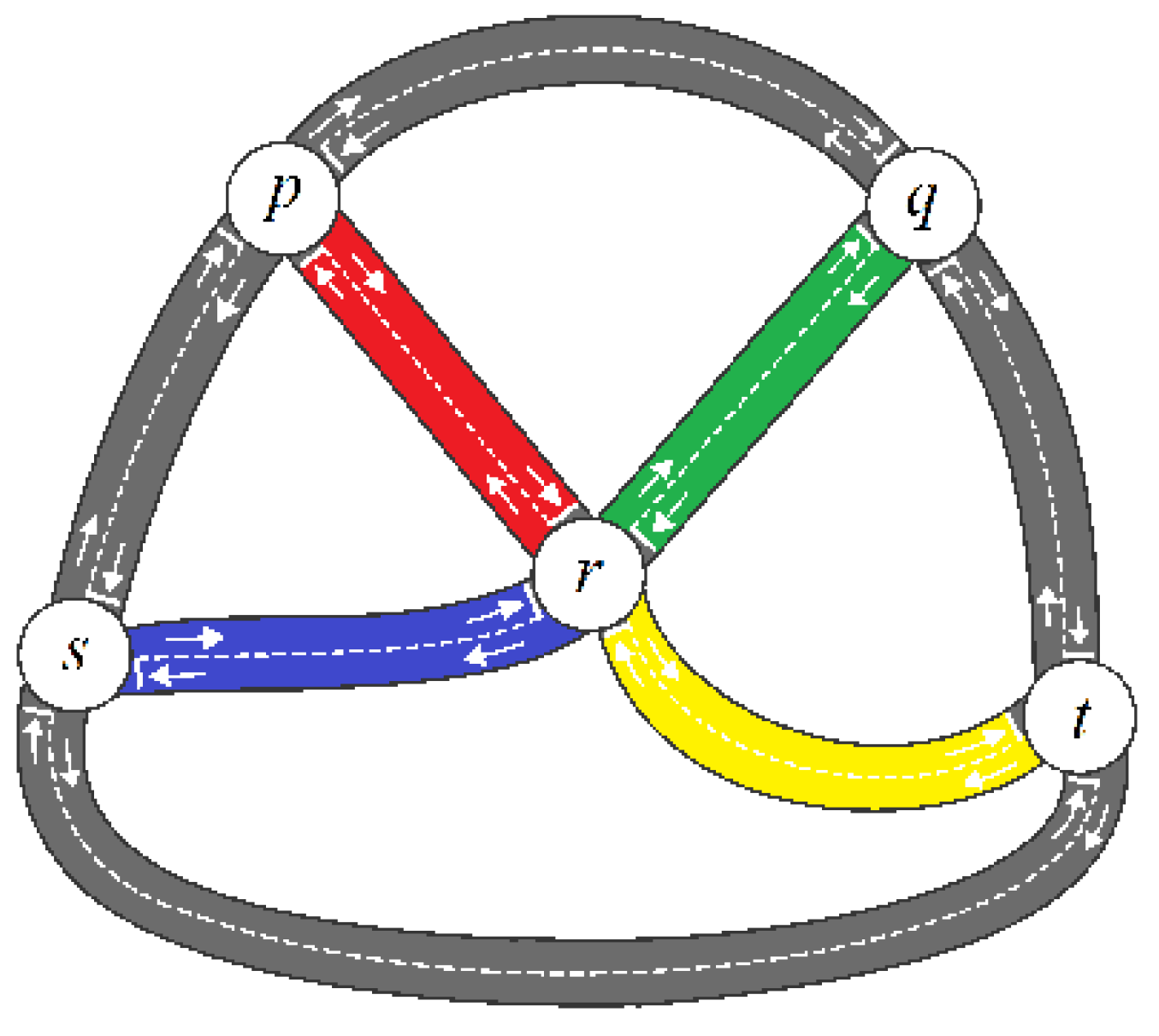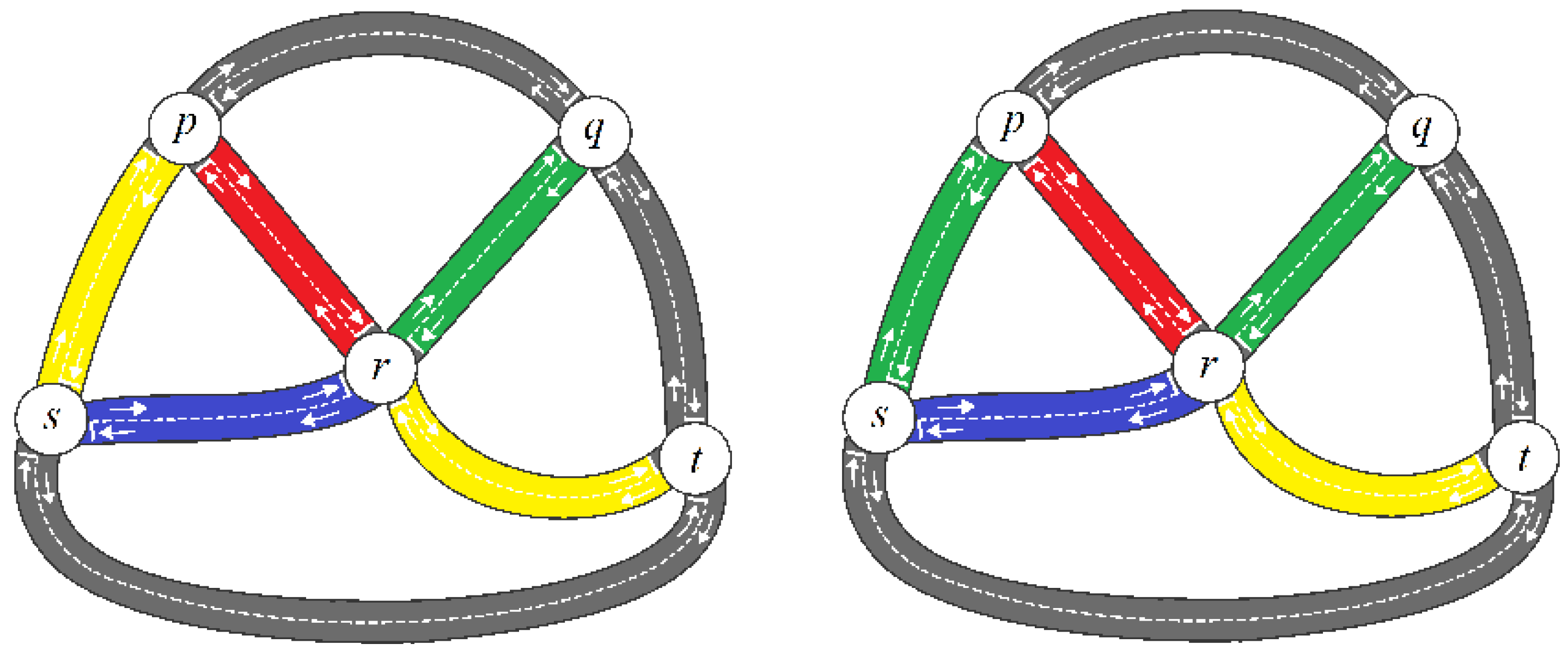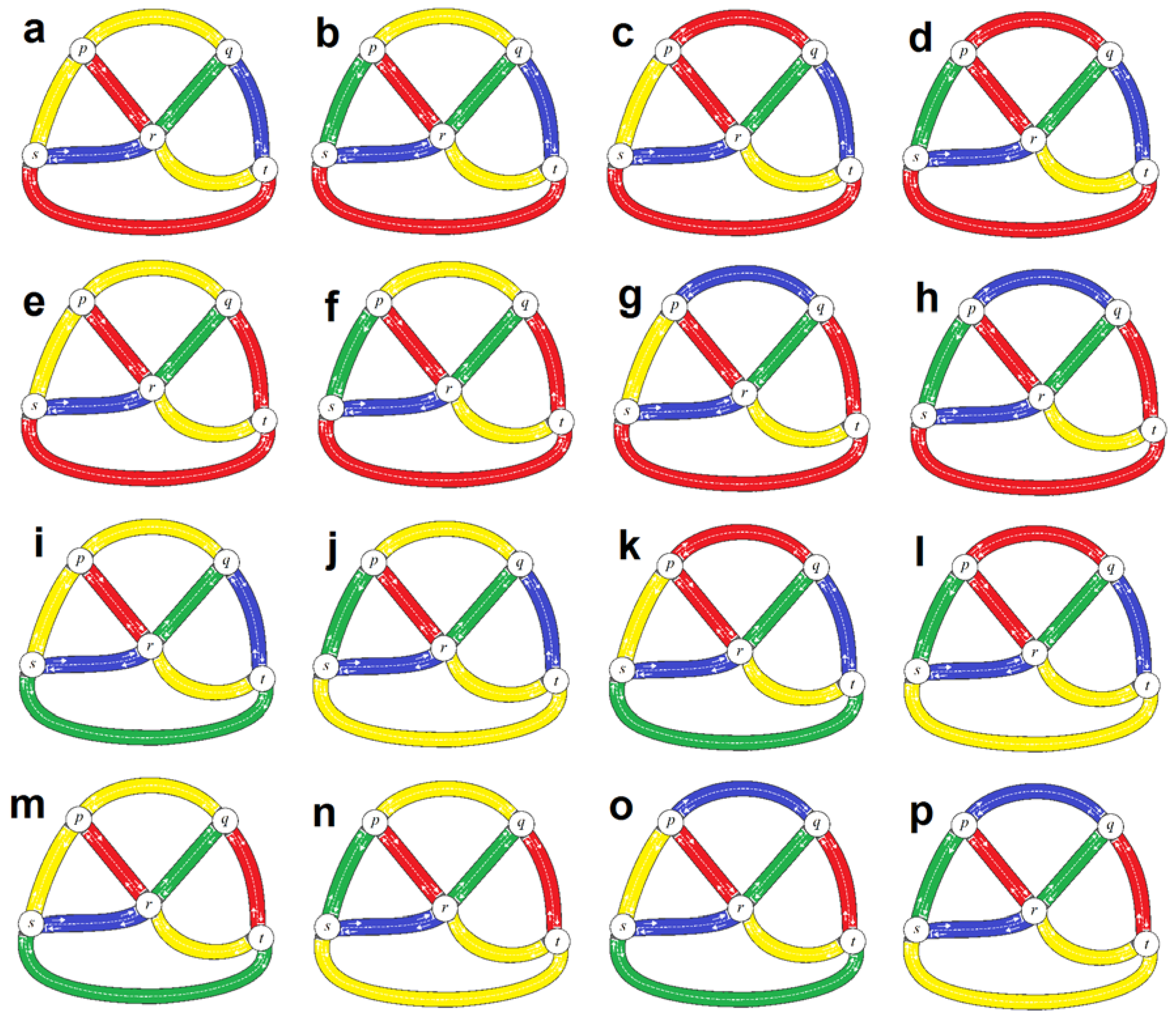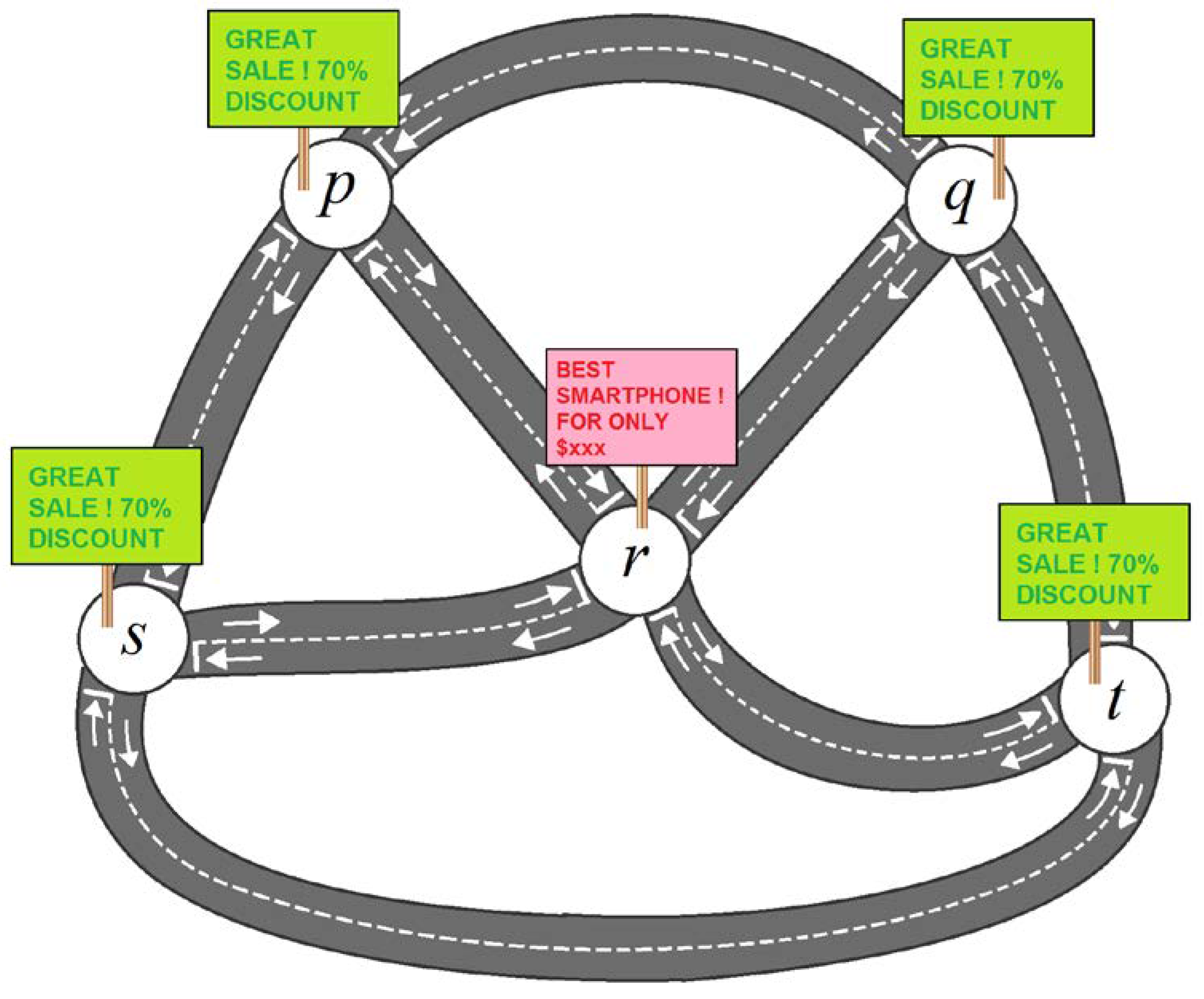1. Introduction
The concept of the fuzzy graph was proposed in the literature [
1] with various definitions pertaining to the cycles, connectivity, and coloring of fuzzy graphs. Subsequently, the vertex strength and types of fuzzy graphs with operations were studied and investigated in the literature [
2,
3,
4]. Some other works focused on the fuzzy total coloring and applications to a traffic light were introduced and studied by Lavanya and Sattanathan [
5]; Jaiswal and Rai [
6]; Samanta, Pramanik, and Pal [
7]; and Kishore and Sunitha [
8]. The density of fuzzy graphs, operations, and dual were introduced in the literature [
9,
10,
11,
12]. Ghorai and Pal [
13] investigated the isomorphic properties of fuzzy graphs, whereas Ghorai and Pal [
14] proposed the concept of regular bipolar fuzzy graphs and studied its applications. Fuzzy graph theory has also been extended to other extensions of fuzzy sets, such as vague sets.
In this paper, we study some new concepts related to the edge coloring of vague graphs. The vague set model was firstly introduced by Gau and Buehrer [
15] in 1993, by replacing the membership degree of an element in a set with a subinterval between 0 and 1. A vague set,
, is described by a true membership function,
, and a false membership function,
, from the universe of discourse,
. Thus, the grade of membership of an element,
, in vague set,
, is bounded to the subinterval,
of
, and the sum of two degrees, that is,
and
must be less than 1.
In fuzzy set theory, the grade of membership of an object to a fuzzy set indicates the belongingness degree of the object to the fuzzy set, which is a point (single) value selected from the unit interval
. In real life scenarios, a person may consider that an element belongs to a fuzzy set, but it is possible that that person is not sure about it. Therefore, hesitation or uncertainty may exist in which the element can belong to the fuzzy set or not. The traditional fuzzy set is unable to capture this type of hesitation or uncertainty using only the single membership degrees. A possible solution is to use an intuitionistic fuzzy set or a vague set [
15] to handle this problem. For example, in a traffic control system of a city, 10 sensors
can be used to store the waiting time of traffic flow with 10 corresponding measurements
at a specific time,
t. Here, ‘_’ represents that the information of a sensor is not captured at time,
t. We find three for six times, four for one time, five for one time, and two missing values. This uncertain information can be represented as a vague set,
A, as follows
. In the measurement, three occur for six times, but two values (i.e., 4 and 5) are against it and two values are missing values. The true membership degree
and false membership degree
are 0.6 and 0.2
, respectively. The vague membership degree is computed as
for three. Similarly, the vague membership degree is obtained
for four, and
for five. The vague set can be represented as
. The above real-life problem describes that, by using a vague set, it is more capable to manage the uncertain information than fuzzy set [
16].
Some concepts related to vague graphs, such as the Laplacian matrix and spectrum, were introduced in Borzooei and Rashmanlou [
17], whereas the isomorphic properties of vague graphs were studied in Talebi et al. [
18]. Borzooei, Rashmanlou, and Mathew [
19] defined the homomorphism of vague graphs. Samanta et al. [
20] studied the behaviour of vague graphs, and presented an investigation on the strength of vague graphs, which was then further investigated in [
21]. Rashmanlou et al. [
22] introduced vague h-morphism. Darabian et al. [
23] studied the concepts of regularity and irregularity in the study of fullerene molecules, wireless multihop networks, and road transport networks. Borzooei and Rashmanlou [
24] introduced further results on vague graphs in the form of three types of new product operations of vague graphs and verified the rationality of these concepts. Borzooei et al. [
25] introduced the concept of strong domination numbers of vague graphs and presented methods to determine the strong domination numbers for any complete vague graph.
The edge coloring problem is an important area of study in fuzzy graph theory, which could be used to solve many real life problems (such as traffic, etc.) [
4,
5,
6,
7,
8]. The main contribution of this paper is as follows.
In the literature, to the best of our knowledge, there is no study on the edge coloring problem for vague graphs until now. Therefore, in this paper we study the concept of vertex and edge coloring on simple vague graphs.
We also demonstrate the utility of these concepts in solving practical problems related to traffic flow management and selection of advertisement spots that will optimize the visibility of the advertisements.
We also introduce the idea of -strong-adjacent and -strong-incident of vague graphs.
2. Preliminary
For the remaining part of this paper, the collection of all fuzzy sets on a set, , shall be denoted by . The symbol shall be used to denote a T-norm function (e.g., the minimum), with being its respective T-conorm (i.e., S-norm).
Definition 1 [5].Letbe a set. Letandbe two functions satisfyingfor all.
We have, the following: - (a)
is said to be a fuzzy graph;
- (b)
is said to be the vertex set of. Eachis said to be a vertex in;
- (c)
is said to be the edge set of. Eachis said to be an edge * in;
- (d)
is said to be the membership value of the vertexin;
- (e)
is said to be the membership value of the edge *in.
Remark 1. In the literature [5], it was assumed thatandfor all.
Definition 2 [5].Letbe a fuzzy graph. Letbe two vertices in. If, thenandare said to be strong adjacent to each other. Definition 3 [5].Letbe a fuzzy graph. Let. Letfor which (i);
(i.e.,for all);
(ii);
(i.e.,for all), for all;
(iii) for each pair of strongly adjacent,
we have he following: Then,is said to be a-fuzzy vertex coloring of.
Definition 4 [5].Letbe a fuzzy graph. The least value of, for which a-fuzzy vertex coloring ofexist, is called the fuzzy vertex chromatic number of, and shall be denoted by.
Definition 5 [5].Letbe a fuzzy graph. Let. Letfor which (i).
(i.e.,for all)
(ii)(i.e.,for all), for all.
(iii) for each, and for eachandstrong incident towards:
Then,is said to be a-fuzzy edge coloringof.
Definition 6 [5].Letbe a fuzzy graph. The least value of, for which a-fuzzy edge coloring ofexists, is called the fuzzy edge chromatic number of, and shall be denoted by.
Definition 7 [26].Letbe a set. Let, whereare two functions satisfyingfor all.
Then, we have the following: - (a)
is said to be a vague set on;
- (b)
is said to be the least membership ofin;
- (c)
is said to be the greatest membership ofin.
Remark 2. for all.
For the remaining part of this paper, the collection of all vague sets on a setshall be denoted by.
Definition 8 [17].Letbe a set. Letand, whereandare four functions satisfying the following: (i)andfor all;
(ii)andfor all.
Then, we have the following:
- (a)
is said to be a vague graph;
- (b)
is said to be the vertex set of. Eachis said to be a vertex in;
- (c)
is said to be the edge set of. Eachis said to be a directed edge in;
- (d)
is said to be the least membership value of the vertexin;
- (e)
is said to be the greatest membership value of the vertexin;
- (f)
is said to be the least membership value of the directed edgein;
- (g)
is said to be the greatest membership value of the directed edgein.
Definition 9 [17].Letbe a vague graph. Letbe two distinct vertices in. If bothandholds, thenis said to be an (ordinary) edge in.
Definition 10 [17].Letbe a vague graph. If bothandholds for all, thenis said to be ordinary. Otherwise,is said to be directed. Definition 11 [17].Letbe a vague graph. If bothandholds for all, then is said to be simple.
To facilitate further discussion, we present two new definitions (Definitions 12 and 13) for vague graphs, related to the concept of-strong-adjacent and-strong-incident of vague graphs.
Definition 12 Letbe a vague graph. Letbe two vertices in. Let.
If bothholds, thenis said to be-strong adjacent to. Moreover, if bothandholds, thenandare said to be mutually-strong adjacent. Remark 3. With regards to the definition, if(i.e., 50%), for instance, thenis said to bestrong adjacent (or 50% strong adjacent) to.
Definition 13. Letbe a vague graph. Letbe two vertices in. Let.
If bothholds, thenis said to be-strong incident towards.
Remark 4. With this definition, wheneveris-strong incident towards,is also-strong adjacent to, because ofand. The need for these definitions will be illustrated in the examples in the subsequent sections.
Definition 14 [22].Letbe a vague graph.is said to be complete ifandfor all.
Remark 5. Whenis complete, it is ordinary and with all pairs of vertices mutually 100% strong adjacent to each other.
Definition 15 [22].A vague graph is said to be Eulerian if all of the edges in the graph are strongly connected and have a cycle from any vertex as the origin and terminal. 3. Vertex and Edge Coloring on Simple Vague Graphs
In the previous section, we discussed the concept of level sets for identifying the vertex coloring on vague graphs. In this section, we consider the color classes to analyze coloring on vertices in vague graphs. The concept of coloring on vague graphs using the definition of color class depends only on the truth membership function, which is the lower bound of the vague set. We do not consider the lower bound of the vague set, which carries the negation of false membership values. The following definitions are only for the case of the truth membership values of the vague graphs.
Definition 16. Letbe a vague graph. Let. Letfor which
(i);
(i.e.,andfor all)
(ii)
(i.e.,andfor all), for all;
(iii) for each pair of mutually-strong adjacent, we have the following: Then,is said to be a-strongvague vertex coloring scheme (abbr.-VCS) of.
Definition 17. Letbe a vague graph. The least value of, for which a-strong k-vague vertex coloring ofexist, is called the-strong vague vertex chromatic number of, and shall be denoted by. Moreover, awhereis said to be a-strong minimal-vague vertex coloring scheme (abbr.-VCS) of.
Definition 18. Letbe a vague graph. Letbe a-VCS of. Then,
- (a)
is said to be the minimum amount ofbyon;
- (b)
is said to be the lower chromatic weight of;
- (c)
is said to be the maximum amount ofbyon;
- (d)
is said to be the upper chromatic weight of.
Definition 19. Letbe a vague graph. Let. Letfor which
(i);
(i.e.,)
for all)
(ii)
(i.e.,andfor all),
for all;
(iii) for each, and for eachand, both-strong incident towards are as follows:
(iv) for each:andfor all.
Then,is said to be a-strong-vague edge coloring scheme (abbr.-ECS) of.
Definition 20. Letbe a vague graph. The least value of, for which a-strong-vague edge coloring ofexist, is called the-strong vague edge chromatic number of, and shall be denoted by. Moreover, awhereis said to be a-strong minimal-vague edge coloring scheme (abbr.-ECS) of.
Definition 21. Letbe a vague graph. Letbe a-ECS of. Then, we have the following:
- (a)
is said to be the minimum amount ofbyon;
- (b)
is said to be the lower chromatic weight of;
- (c)
is said to be the maximum amount ofbyon;
- (d)
is said to be the upper chromatic weight of.
